Local public technology centres (Kosetsushi) in Japan have demonstrated notable success in fostering the development of regional industries. This column reports the results of the first branch-level survey of Kosetsushi, focusing on three areas: manufacturing, foods, and design. Kosetsushi are found to help clients through diverse, tailored technical consultations and, increasingly, by acting as a network hub for the transfer of symbolic and analytical knowledge. These findings have particular relevance for regional governments attempting to foster innovation through similar institutions.
Kosetsushi (local public technology centres) are technology transfer organisations established and administrated by prefectural (Note 1) or municipal governments in Japan. They were initially established in the late 19th century for agriculture, textiles, and brewery (e.g. sake and soy sauce), and have since then gradually developed for manufacturing in general. Currently, there is at least one manufacturing Kosetsushi in each prefecture. They are recognised as important organisations that have helped local industries, particularly small and medium-sized enterprises (SMEs) since the early phase of Japan's economic development. It is not uncommon to have agricultural extension service centres throughout a country to help farmers. However, few countries have had such local technology transfer organisations for manufacturing. At least partially inspired by Japan's experiences, some developed countries have established technology diffusion programs for SMEs as a part of their regional innovation policies. Examples include the Manufacturing Extension Partnership (MEP) in the US, the Industrial Research Assistance Program (IRAP) in Canada, the Steinbeis Foundation in Germany, Regional Board for Economic Development (ERVET) in Emilia-Romagna of Italy, Technology Innovation Centres (TIC) in the UK, and the Netherlands Organisation for Applied Scientific Research (TNO) (Shapira et al. 2011). Developing countries have started to introduce similar systems. Previous studies provide statistical evidence that such programs have had a positive impact on their clients' labour productivity growth (Jarmin 1999, examining MEP) and innovations (Ponds et al. 2010, examining TNO).
In the context of innovation studies, Kosetsushi can be interpreted as a form of an innovation intermediary. Innovation intermediaries are individuals or organisations that help others innovate by acting either as a networking mediator, or an external source of knowledge (Howells 2006, Intarakumnerd and Chaoroenporn 2013). Innovation intermediaries are particularly important for SMEs that tend to suffer from:
- Market failure, which hinders them from appropriating innovative returns; and
- Systemic failure, which makes it difficult for them to tap into potential sources of knowledge.
As an innovation intermediary, Kosetsushi play three key roles in regional innovation systems:
- They diffuse technological knowledge through various routes, such as testing, use of analytical equipment, technical consultation, joint research, and seminars for engineer education;
- They conduct their own research, patent inventions, and license patents mainly to local SMEs; and
- They act as a catalyst for local SMEs to develop innovative networks to external sources of knowledge.
Although it has been recognised that technical consultation is the most important channel for technology transfer, essentially no reliable statistics exist that define and measure this activity. Our recent study is the first to investigate such technical consultation, gathering information from a survey conducted at the branch level (Fukugawa and Goto 2016).
Findings from the survey
The survey targeted all Kosetsushi branches engaged in technology transfer in manufacturing, foods, and design (see Table 1).
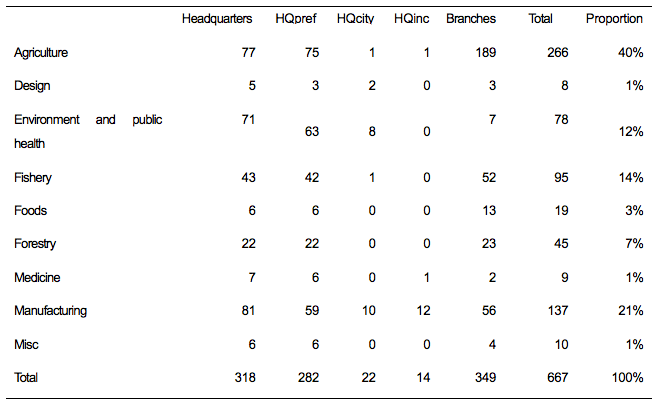
Note: HQpref denotes Kosetsushi administrated by prefectural governments. HQcity denotes Kosetsushi administrated by municipal governments. HQinc denotes Kosetsushi incorporated.
Prefectures have on average six or seven Kosetsushi headquarters, and approximately half of the 667 Kosetsushi are classified as their branches. Though not to the same extent as agricultural ones, manufacturing Kosetsushi have many branches. This is because they tend to have branches based on the specific technology development in each region, such as ceramics. Technology transfer activities can be diverse even within a prefecture. Therefore, collecting information on Kosetsushi exclusively at the headquarter level would make it difficult to understand the true state of their activities. Questionnaires were sent to 153 headquarters and branches in October 2015, inquiring about technical consultation they conducted in fiscal year 2014, and the response rate was 72.6%. This survey defined technical consultation as "provision of solutions to problems via phone, mail, and interpersonal communications for unspecified individuals and firms". Table 2 shows that most of the clients are local firms and had consulted Kosetsushi regarding their problems before fiscal year 2014.
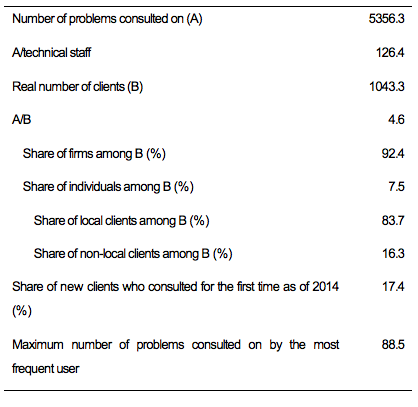
The key findings can be summarised as follows. First, Kosetsushi solve various (technological and non-technological) problems through technical consultation (see Table 3). What is notable is that a non-negligible proportion of the problems have to do with design. Second, these problems are diverse in terms of complexity (see Table 4). Design problems tend to require more than a year to be solved, whereas problems in chemicals tend to be solved in a day. Third, technical consultation acts as a gateway to further technology transfer activities (see Table 5). Kosetsushi that frequently deal with problems in electrical and mechanical engineering tend to solve them through physical asset services (e.g., inspection and rental equipment). Those dealing with design problems, on the other hand, tend to do so through personal interactions (e.g. technical guidance and joint research). Fourth, Kosetsushi act as a mediator that connects SMEs to other sources of knowledge, such as universities, when the problems are too difficult to solve internally (see Table 6). Kosetsushi addressing more problems in chemicals tend to connect clients to universities, whereas those in design tend to link clients to public research institutes and firms. Fifth, Kosetsushi believe that technical consultation contributes to their researchers' better understanding of local firms' technological needs, which are salient for Kosetsushi frequently dealing with design problems (see Table 7).
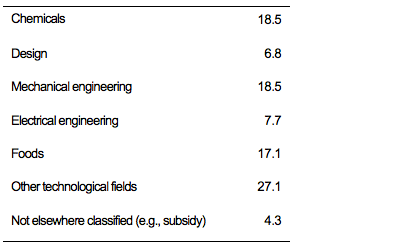
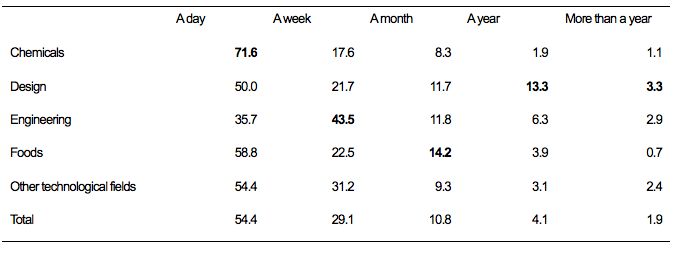
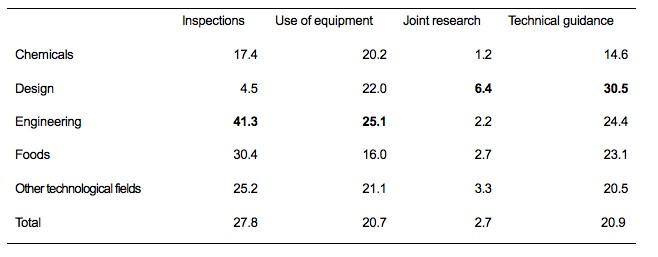
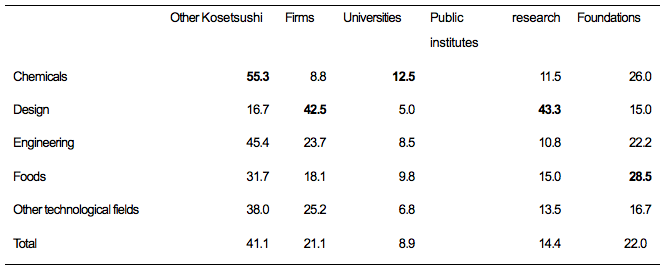
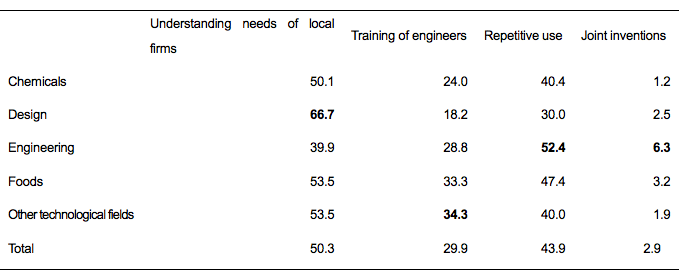
Policy implications regarding problem solving and intermediation
The results suggest that technical consultation acts not only as a means of problem solving for local SMEs' daily operations, but also as a means of intermediation. Regarding problem solving, the nature of the problems SMEs face vary across technological fields, reflecting different ‘industrial knowledge bases’ (i.e. characteristics of knowledge on which industrial innovations build) (Asheim et al. 2007).
Solving problems in design requires the sharing of ‘symbolic knowledge’ (i.e. knowledge generated through attempts to create cultural meanings embodied in shapes, images, and cultural artefacts) that tends to be tacit. As tacit knowledge is hard to transfer via documents, solutions to design problems tend to be found through dense personal interactions, which generally require more time. This tacit nature of the knowledge to be transferred makes geographical proximity between a user and provider of knowledge important.
In chemicals, on the other hand, innovative activities tend to build on ‘analytical knowledge’ (i.e. knowledge generated through attempts to explore and explain universal principle of nature) which can be communicated in a universal language like mathematical or chemical equations, and thus is readily transferable through licensing which is less geographically constrained (Fukugawa 2016). Indeed, the geographical distribution of clients indicates that geography matters in design, whereas this is not the case in chemicals (see Table 8). Therefore, the technology transfer channels most needed by local SMEs and the regional embeddedness of Kosetsushi are complementary and contingent on industrial knowledge bases or sectoral innovation systems (i.e., sectoral patterns of knowledge creation and dissemination).
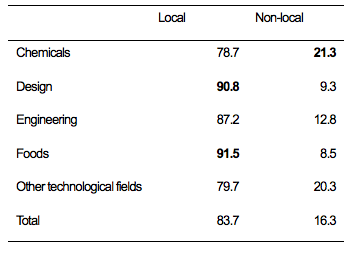
These branch-level results shed new light on the development strategy of Kosetsushi, which cannot be obtained from a headquarter level analysis. Even though each Kosetsushi's activities are limited within the prefecture where it is located, as Kosetsushi are a part of the prefectural government, policymakers should be aware that, in order to devise an effective regional innovation policy, it is necessary to take account of characteristics of sectoral innovation systems in and beyond the region. Kosetsushi could make technology transfer more efficient by expanding the geographical coverage of licensing activities beyond jurisdictional borders, thereby generating economies of scale and scope through access to various potential licensees while spreading out the administrative cost (Lach and Schankerman 2008). Furthermore, there are several agglomerations with different industrial knowledge bases in a prefecture. If some of them lie across jurisdictional borders and build on synthetic knowledge (i.e. knowledge generated through attempts to design something that works as a solution to a practical and more applied problem) or symbolic knowledge, it is reasonable for Kosetsushi to expand the geographical coverage of technical consultation by devising innovative budgeting.
Regarding the intermediary function, Kosetsushi frequently dealing with problems in design appear to have connected clients to firms with a design division or individual designers. On the other hand, Kosetsushi frequently dealing with problems in chemicals tend to link clients to universities, which is in line with the fact that chemicals are a science-based sector where academic knowledge is an important innovative input. Unreported results show that the ratio of PhD researchers at Kosetsushi is positively correlated with the tendency of Kosetsushi to link clients with unsolved problems to universities. This suggests the possibility that researchers with higher educational backgrounds have advantages in linking clients to universities because of their richer personal networks to universities. This implies that, in agglomerations of a science-based sector, quality improvement in human capital of Kosetsushi not only enhances internal research quality, but also upgrades the intermediary function.
Since 2000, most local governments have been drastically reducing budgets for Kosetsushi, reflecting a substantial reduction in state aid. Under such circumstances, the intermediary function becomes more significant for Kosetsushi, as providing solutions exclusively based on their internal capabilities becomes harder. Creating a pool of local firms and individuals as a potential source of knowledge could enhance how Kosetsushi address clients' unsolved problems, thereby augmenting knowledge flow and innovations in the region.
Editors' note: The main research on which this column is based appeared as a Discussion Paper of the Research Institute of Economy, Trade and Industry (RIETI) of Japan.
This article first appeared on www.VoxEU.org on July 8, 2016. Reproduced with permission.



